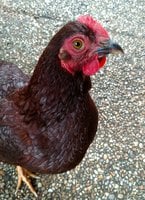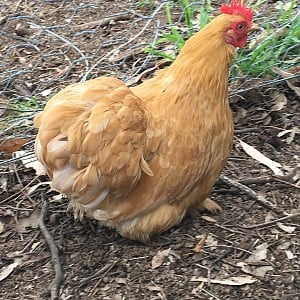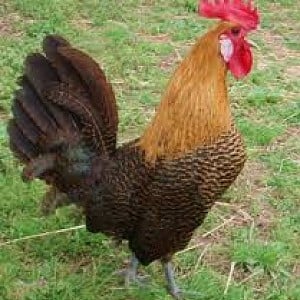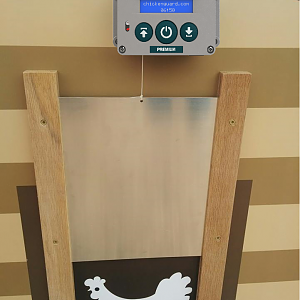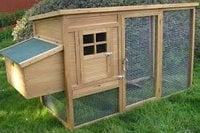Navigation
Install the app
How to install the app on iOS
Follow along with the video below to see how to install our site as a web app on your home screen.
Note: This feature may not be available in some browsers.
More options
You are using an out of date browser. It may not display this or other websites correctly.
You should upgrade or use an alternative browser.
You should upgrade or use an alternative browser.
Reviews by BDutch
Filters
Show only:
Loading…
- BDutch
- 4.00 star(s)
Pros: Small, good layers in winter, friendly
Cons: Going to find out
I can’t say much. But I will add more info as soon as know more.
I found this info about the RIR bantams on the dite of the Dutch RIR club:
The bantam form originated in England in the 1920s. The laying power of the bantams is even better than their big brothers and sisters. With proper care, she will continue to lay throughout the winter.
Here too there is a variety in comb shape.
Unlike the large Red, the bantams can be kept just about anywhere as they require relatively little space.
I found this info about the RIR bantams on the dite of the Dutch RIR club:
The bantam form originated in England in the 1920s. The laying power of the bantams is even better than their big brothers and sisters. With proper care, she will continue to lay throughout the winter.
Here too there is a variety in comb shape.
Unlike the large Red, the bantams can be kept just about anywhere as they require relatively little space.
- Purchase Price
- 10 $ for 10 eggs
- Purchase Date
- This spring
BDutch
The eggs were hatched by a broody and the youngsters didn’t turn out to be tame at all. I have 2 pullets and one cockerel 3 months old now. They do great in my flock and love to free range.
BDutch
Another update. The cockerel turned out into a very friendly boy. But I couldn’t keep him bc the neighbours complained about the crowing in the morning. Luckily I could rehome him.
The 2 pullets started to lay after winter (February). And they make a strange deep noise. Quit a different sound then the shrieking (birdlike) sounds of my other chickens.
They are great bantam layers now. About 5 eggs a week.
The 2 pullets started to lay after winter (February). And they make a strange deep noise. Quit a different sound then the shrieking (birdlike) sounds of my other chickens.
They are great bantam layers now. About 5 eggs a week.
Pros: They are all small
Cons: different breeds and mixes
I hope people who read this will understand that bantam has to do with size and not with breed.
Different kind of bantams have different looks and different characteristics. If you want information about a certain bantam, you better look at the kind of bantam you are interested in:
More about bantams from
https://www.thehappychickencoop.com/bantam-chickens/
“In total the American Bantam Association lists over 400 varieties of bantam birds.
The origin of the word ‘bantam’ is from the seaport of Bantan, Indonesia.
When sailors stopped into the port for fresh supplies of food and water, they were impressed by the local chickens which were smaller than the chickens back home. The word – Bantan – was corrupted into Bantam in general English and so small chickens became known as bantams.
Types of Bantam Chickens
Strictly speaking there are three types of bantam chicken.
Different kind of bantams have different looks and different characteristics. If you want information about a certain bantam, you better look at the kind of bantam you are interested in:
More about bantams from
https://www.thehappychickencoop.com/bantam-chickens/
“In total the American Bantam Association lists over 400 varieties of bantam birds.
The origin of the word ‘bantam’ is from the seaport of Bantan, Indonesia.
When sailors stopped into the port for fresh supplies of food and water, they were impressed by the local chickens which were smaller than the chickens back home. The word – Bantan – was corrupted into Bantam in general English and so small chickens became known as bantams.
Types of Bantam Chickens
Strictly speaking there are three types of bantam chicken.
- There are ‘true’ bantams; these have no large fowl counterpart. They are naturally occurring with no input from mankind. Breeds: Nankin, Sebright and Rosecomb.
- Miniaturized bantams – these were ‘made’ from a standard breed of choice such as Rhode Island Red, Cochin or Orpingtons.
- Developed bantams – these are small breeds that have been further developed with some help from mankind. They have been around for so long that the origins are sketchy at best. Such breeds are: Belgian, Pekin (Cochin) and Japanese.”
- BDutch
- 4.00 star(s)
Pros: Beautifull. Good layer. Good survivor
free ranging in a forest.
free ranging in a forest.
Cons: Flightly. Hard to tame. Flies high.
There are two varieties. Golden and silver campines. A few years ago I wanted to buy the bantam breed because of the pro's. But eventually I did not because of the cons.
Information from a Dutch site (levende have) about this breed:
The Campine also caused a furore in America.
The old type of Campine had an excellent reputation as a laying hen, and therefore received the prestigious title "The Everyday Layer" in England. The refined meat, even reminiscent of game, was in great demand. In 1914 the Campine was admitted to the American Standard of Perfection by the APA (American Poultry Association). A milestone in the existence of the then very young breed. Breeder Maarten Jacobs from Deurne near Antwerp has brought the Campines back to the Kempen. The first chickens (eggs) came from the United States, England and Denmark. From Belgium, the first Kempian fowls have also returned to the Dutch Kempen in Eersel.
Characteristics of the Campine (in the Netherlands/Belgium):
The Campine is hardened and weatherproof so does not need a luxurious night stay. If it is up to this chicken itself, he prefers an ordinary tree as a shelter from the weather. So high up he has nothing to fear from natural enemies like the fox. The Campine converts food into growth and lay in a very efficient way. The grouse combines a fine bone structure with a very meaty chest for its weight class. He is an economic eater and likes to collect his own food. In that respect, he still has many characteristics of his distant ancestor, the Bankiva woodland. He likes to forage in the forest where he can gather an extensive diet of critters, berries and grains. A group of Campines would therefore do well in an area with alternating low, medium-high and high vegetation, as a result of which the Campine holder can earn extra income from, for example, fruit growing. The Campine is also a very sustainable variety that is resistant to diseases. The Campine has a constant leg which means that it hardly ever inserts a winter break and that the effect of the moulting period is minimal. He is also a good laying hen during his 2nd and 3rd year of life, so that the rearing costs can be spread over a longer period.
Information from a Dutch site (levende have) about this breed:
The Campine also caused a furore in America.
The old type of Campine had an excellent reputation as a laying hen, and therefore received the prestigious title "The Everyday Layer" in England. The refined meat, even reminiscent of game, was in great demand. In 1914 the Campine was admitted to the American Standard of Perfection by the APA (American Poultry Association). A milestone in the existence of the then very young breed. Breeder Maarten Jacobs from Deurne near Antwerp has brought the Campines back to the Kempen. The first chickens (eggs) came from the United States, England and Denmark. From Belgium, the first Kempian fowls have also returned to the Dutch Kempen in Eersel.
Characteristics of the Campine (in the Netherlands/Belgium):
The Campine is hardened and weatherproof so does not need a luxurious night stay. If it is up to this chicken itself, he prefers an ordinary tree as a shelter from the weather. So high up he has nothing to fear from natural enemies like the fox. The Campine converts food into growth and lay in a very efficient way. The grouse combines a fine bone structure with a very meaty chest for its weight class. He is an economic eater and likes to collect his own food. In that respect, he still has many characteristics of his distant ancestor, the Bankiva woodland. He likes to forage in the forest where he can gather an extensive diet of critters, berries and grains. A group of Campines would therefore do well in an area with alternating low, medium-high and high vegetation, as a result of which the Campine holder can earn extra income from, for example, fruit growing. The Campine is also a very sustainable variety that is resistant to diseases. The Campine has a constant leg which means that it hardly ever inserts a winter break and that the effect of the moulting period is minimal. He is also a good laying hen during his 2nd and 3rd year of life, so that the rearing costs can be spread over a longer period.
- Purchase Price
- 1 euro for fertile eggs.
- Purchase Date
- -
- BDutch
- 4.00 star(s)
Pros: Don't need to get up at dawn to let the chickens in the run, warning light before batteries go flat, choose the light intensity to open and close
Cons: Not very ergonomic to install and to change batteries, quit expensive for such a simple apparatus.
This ChickenGuard door opener is really wonderfull. Especially in the summer when the chickens are awake long before I get out of my bed. They can go into the run soon after the sun comes up. In the evenening when my birds are roosted the opening to the run closes automaticly. This way my chickens are more safe during the night. I have this ChickenGuard for 8 months now and never had any problems of disfunction.
I only bought the the electronic box and made the closing shelf with an old plastic trencher who had just the right size. The closing shelf drops smoothly between two wooden strips with a recess/groove.
One more thing. We easily go out for a weekend or a holliday because it's no burden for our neighbours to to take care of our flock. They only have to supply fresh water and food once a day. In return the get the eggs. The only problem since we have this opener is, that we have a lot of neighbours who like to babysit my chickens.

P.S. My chicken guard still works great after 4.5 years. Only once a year I need to replace the batteries.
I only bought the the electronic box and made the closing shelf with an old plastic trencher who had just the right size. The closing shelf drops smoothly between two wooden strips with a recess/groove.
One more thing. We easily go out for a weekend or a holliday because it's no burden for our neighbours to to take care of our flock. They only have to supply fresh water and food once a day. In return the get the eggs. The only problem since we have this opener is, that we have a lot of neighbours who like to babysit my chickens.

P.S. My chicken guard still works great after 4.5 years. Only once a year I need to replace the batteries.
- Purchase Price
- € 150
- Purchase Date
- 2015
BDutch
Many years later my chicken guard had a malfunction after a leakage. It got stuck on a wet thread. After drying and resetting (with support of the seller) it works great again.
It still works after 7 years.
It still works after 7 years.
- BDutch
- 3.00 star(s)
Pros: cheap, handy, easy to clean, nice nesting boxes, safe mash
Cons: small, sleeping sticks too low, needs better roofing after two years
I have a similar chicken coop. After two years I made a new roof over the old one because it started to leak. The connexion with the nesting boxes (hinge) was leaking and i made something waterproof over it.
The covered run is quit open and gives little shelter when is windy and raining and you put it in an open field. The food gets easily wet. You need to keep the chickendoor open for ventilation or its getting easily too warm inside. The run is way to small to keep the chickens in 24x7. Therefore a second (open) run or free range is needed for happy chickens.
Last year I had 4 dutch bantams in it. And it was quit small for them. Now I have 6 dutch and I build an extension to this coop with perches at 50 cm from the ground. They started to use these to sleep on when the chicks grew older. I painted (all cracks in) the wood with diatomaceous earth to prevent an outburst of lice.
I hope the coop lasts a couple of years more with all the improvements.
The covered run is quit open and gives little shelter when is windy and raining and you put it in an open field. The food gets easily wet. You need to keep the chickendoor open for ventilation or its getting easily too warm inside. The run is way to small to keep the chickens in 24x7. Therefore a second (open) run or free range is needed for happy chickens.
Last year I had 4 dutch bantams in it. And it was quit small for them. Now I have 6 dutch and I build an extension to this coop with perches at 50 cm from the ground. They started to use these to sleep on when the chicks grew older. I painted (all cracks in) the wood with diatomaceous earth to prevent an outburst of lice.
I hope the coop lasts a couple of years more with all the improvements.
- Purchase Date
- 2012-10-05
BDutch
7 years laters (now this coop is over 10 years old) I still have it with even more alterations and adding a natural conservative.
This coop is in use for the handy nest boxes (now with an epdm cover against leaking and a piece of sunscreen against the heat in the summer). The little covered run is handy when it rains (I added a large window at the west side) and convenient to keep the chickens closed in before the light sensored pop door opens in the morning.
Sometimes when there is a lot a fuss, one or two chickens prefer to sleep in the coop (made the roosts a bit higher).
This coop is in use for the handy nest boxes (now with an epdm cover against leaking and a piece of sunscreen against the heat in the summer). The little covered run is handy when it rains (I added a large window at the west side) and convenient to keep the chickens closed in before the light sensored pop door opens in the morning.
Sometimes when there is a lot a fuss, one or two chickens prefer to sleep in the coop (made the roosts a bit higher).

